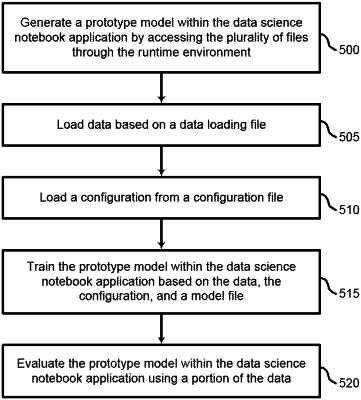| CPC G06N 20/00 (2019.01) [G06F 8/31 (2013.01); G06F 8/64 (2013.01); G06F 8/71 (2013.01); G06F 16/1873 (2019.01)] | 19 Claims |

|
1. A method for developing a machine learning (ML) model, comprising:
initiating, by a data science notebook application, a runtime environment, wherein the data science notebook application comprises a software application for documenting, visualizing, and iterating ML models;
creating, by the data science notebook application, a plurality of files based on a notebook recipe template that includes a model of a file structure for the plurality of files, wherein the plurality of files includes a configuration file indicating hyperparameters for the ML model, a data loading file indicating training data to be loaded for a training stage, and a training file for training the ML model;
generating, by the data science notebook application, a prototype model for the ML model by accessing the plurality of files through the runtime environment;
generating, by the data science notebook application, a production ML package for the ML model by packaging the runtime environment and the plurality of files, the plurality of files including the configuration file, the data loading file, and the training file; and
generating an enterprise ML model for the ML model by running the production ML package, wherein running the production ML package includes setting the hyperparameters, loading the training data, and training the enterprise ML model within the runtime environment.
|